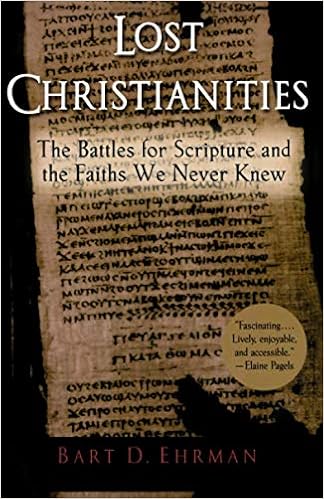The point of this book is largely for Ehrman to explore what Christianity may have become if orthodox Christianity hadn't won out. As such, he looks at various heresies and how those who taught them thought about Jesus--and also how the proto-orthodox pushed their agenda. As Ehrman notes, those proto-orthodox not only won out but also then wrote the history of Jesus and early Christianity, ridding it of the differences that existed in those early years and of the voices of those who taught in a different way. These are all excellent points--and ones would totally agree with.
Now, of course, we have access to some of the original documents that were earlier only available to us in quotes from those arguing against heretical teachers. This was made possible by the discovery of the Nag Hammadi library most especially, among others. Interestingly, the teachings of those arguing against such thinkers turn out to be largely correct about what such people were teaching--or at least that seems to be the case when we read it through the lens of such arguers; take the lens away, and some of the teachings may not be quite as antithetical in all cases.
Ehrman begins his discussion of how we establish authority in Scriptures. He looks at how people wrote pseudo-epigraphically and how such forgeries could affect how people accepted a given work. He argues quite well against those who would say that pseudo-epigraphy was simply a rhetorical device that was accepted (something that seemed a point in John Collins's book on diasporic Jewish writers); as Ehrman notes, the whole point of writing in someone else's voice with their name was to pose as that authority and discovery of a work being "forged" in such a name meant it wasn't accepted as authoritative generally.
Next, Ehrman looks at different forms of Christianity that existed--Ebionites, Marcionites, and Gnostics. The first were more Jewish in temper and emphasized Jesus as human (rejecting Paul's writings); the second were more Gentile in orientation, rejected the Jewish Old Testament and virtually all writings by New Testament writers outside of Paul (and Luke's gospel), and emphasized Jesus as divine. Orthodox Christianity pushed both such views out.
Here's where Ehrman's work gets really interesting. He looks at the New Testament as it comes down to us and largely argues that it was in selecting these books--and the accepted texts for these books--that the proto-orthodox established their authority. The New Testament is not, as Ehrman notes, necessarily as nailed down as we suppose. Ancient manuscripts (of which we have more than any other ancient text) of the books that make up the New Testament include numerous differences. Most of these, Ehrman concedes, are merely spelling errors and other simple and obvious mistakes. But a few suggest an agenda. One of the most interesting sets of differences are passages in Luke, wherein references are made to Jesus's father and mother or parents--in many of the manuscripts such wording is "changed" to emphasize only his mother, the idea being that some had used Luke's references to his parents to say that Jesus had not been conceived by the Holy Spirit. Likewise, the oldest manuscripts (though not the majority of ancient manuscripts overall) have Father saying, in contract to Matthew and Mark, at the time of Jesus's baptism, "This is my beloved Son; today I have begotten you"--instead of "This is my beloved Son in whom I am well pleased." The majority of English translations take up the later version. Ehrman argues the manuscript was changed for the same reason (though this argument supposes that "oldest" is always better--something that I would say is not necessarily the case; the accepted text may be the real whose older versions fell into disrepair and the oldest could well be a changed text that we discovered; either way, though, the discrepancies do show the challenges textual editors/scholars have in defining what the original text was intended to be).
Then Ehrman goes into the subject of how the canon was settled on, again arguing that this was the product of proto-orthodox Christians winning out over the first four centuries. Indeed, if one looks at some second-century works, almost the entire the New Testament is referenced (namely in Polycarp's letter), while in other such works almost none of it is (Shepherd of Hermas, 2 Clement). What constituted Scripture differed from place to place, which is likely true. What is interesting here, however, is that in Asia Minor, it would appear that most of the New Testament was already settled by the time of Polycarp, which to me would suggest that this is where the proto-Orthodox canon formation actually came from, despite the fact that Rome continued to argue over biblical concepts for another several hundred years. In part, that would seem to make more sense because otherwise, it seems odd to me that some of the books we have in the New Testament would be there, as they don't well fit orthodox Christian doctrines. Indeed, modern scholarship to me, seems in a sense, to have taken on a kind of Marcionite canon insofar as most secular scholars now argue that other than about seven of Paul's letters, the rest of the New Testament was written much later and most of it pseudo-epigraphically; as such, we end up almost with an antinomian New Testament in which only a selection of Paul's letters count as truly apostolic.







No comments:
Post a Comment